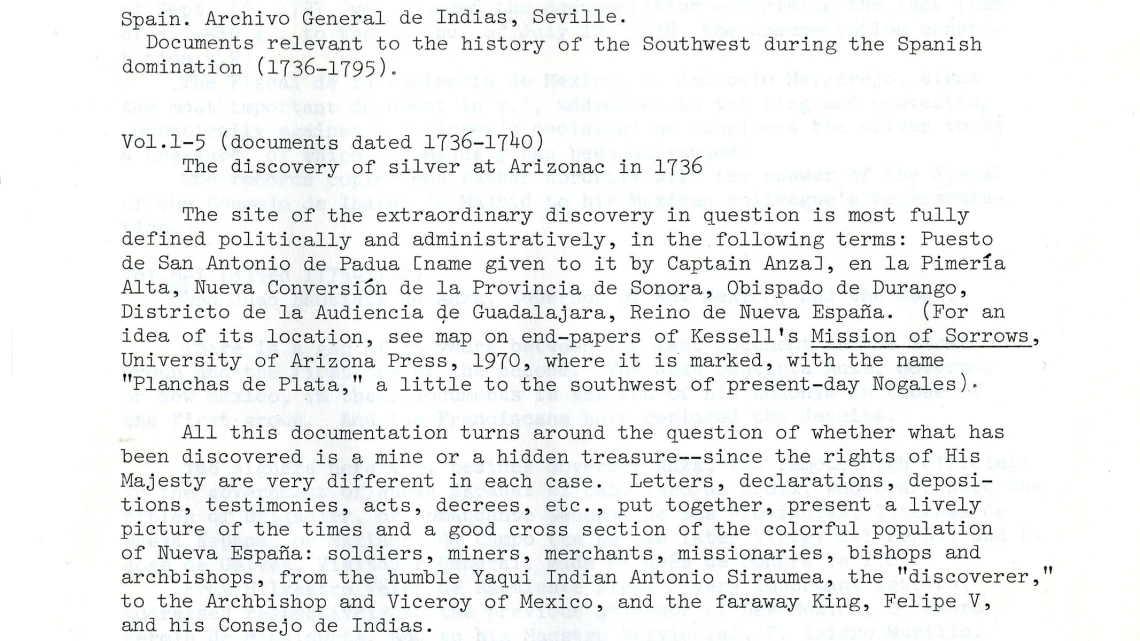Documents relating to Southwest history

Page i from The Discovery of Silver at Arizonac in 1736 April 10, 1737-July 13, 1737.
Collection area: Arizona and Southwest
Collection dates: 1736-1795 (bulk 1736-1740)
Letters and other documents; consists of 7 volumes of typewritten transcripts created in 1925 from the original manuscripts. Volumes 1-5, 1736-1740, cover discovery of silver at Arizonac in the jurisdiction of Juan Bautista de Anza. Volume 6 and the first half of volume 7 deal with the governorship of Juan Bautista de Anza (son of above mentioned) in New Mexico and his policies toward the Moquis, 1775-1782. The second half of volume 7, 1778-1795, concerns the military career of Don José de Zúñiga. English translations of of almost all documents pertaining to Governor Don Juan Bautista de Anza can be found in Alfred Barbaby Thomas,
The Archivo General de Indias, located in Seville, Spain holds documents relating to the history of the Spanish Empire in the Americas and the Philippines. In 1785 Charles III decreed that the archives of the Council of the Indies were to be housed here, to bring together all the documents regarding the overseas empire.
Juan Bautista de Anza, (1693-1740), was born in Basque country before leaving for New Spain when he was nineteen years old. He quickly became involved in several silver mines throughout Sonora. On August 2, 1721, he joined the regular cavalry as an alférez, or second lieutenant, at the Janos Presidio under Captain Antonio Bezerra Nieto. In November of 1726, he was promoted to captain and assigned to Fronteras, where he established several livestock ranches. At the time of the discovery of silver Arizonac in 1736, he was Captain of the Presidio de Santa Rosa de Corodeguachi and Chief Justice for His Majesty in the Province of Sonora. Thus, it fell to him to decide the question of whether the find was a mine or hidden treasure, the answer of which affected ownership rights of His Majesty. Anza continued as a soldier and statesman for the next few years, until May 9, 1740 when he was ambushed and killed by a group of Apaches when coming home from a routine supply trip.
Juan Bautista de Anza’s son, also Juan Bautista de Anza (1735-1788), was Governor of New Mexico from 1777 to 1787. He began his career when he enlisted in the army at the Presidio of Fronteras. His military duties mainly consisted of forays against hostile Native Americans, during the course of which he explored much of what is now Arizona. After the Spanish began colonizing Alta California in 1769, a land route was needed to avoid the long, arduous see voyage. On January 8, 1774 de Anza and a team set out to find the land route. They returned in late May of the same year. In addition, de Anza also found the first overland route to San Francisco Bay, although he did not establish settlement, and a route from Santa Fe to Sonora. On August 24, 1777, the Viceroy of New Spain appointed de Anza as the Governor of the Province of Nuevo Mexico, present day New Mexico. During his tenure as governor, he completed several local military expeditions against tribes defending their homelands. In 1887 he returned to Sonora. He was appointed commander of the Presidio of Tucson in 1788 but died before he could take office.
José de Zúñiga was born in 1755 in Cuautitlán, near Mexico City. He began his military career on October 18, 1781 when he enlisted in the frontier army. On September 8, 1781, he became Commandant of the Presidio of San Diego. In 1792 he was promoted to captain and assigned to the Presidio of Tucson, where he did not arrive until 1794. Zúñiga blazed a trail between Tucson and the Zuni pueblos in 1795, but Apache hostilities prevented that route from becoming well-traveled. During 1804–1806 Zúñiga was the commander at Tucson. He later served at Arizpe, and retired as lieutenant colonel and Adjutant Inspector of Presidios.
A collection guide explains what's in a collection. New to using our collections? Learn how to use a collection guide.
Collection guideAccess this collection
Visit us in person to access materials from this collection. Our materials are one-of-a-kind and require special care, so they can’t be checked out or taken home.
How to cite
Learn how to cite and use materials from Special Collections in your research.
